
Video players have fragile skeletons and break quickly
According to United States Army Major Jon-Marc Thibodeau, today's gamers have a fragile skeleton and break easily. The man called these people the "Nintendo Generation".The United States Army Major, by the term "Nintendo Generation", refers to 18-25 year olds, not fans of 1980s of the consoles of the Grande N, mind you. The man stated that "The skeletons of the Nintendo Generation soldiers are not strengthened by the activities prior to their arrival and some of them break more easily".
An example of "Nintendo Generation": you can see it fragile skeleton? Army Captain Lydia Blondin gave a little more detail on this. "We see injuries ranging from acute fractures and falls, to tears of the anterior cruciate ligament, to muscle strains and stress fractures, with the vast majority of injuries related to overuse."
We can assume that what the Major meant is that today's young people have on average a more sedentary life than many years ago, consequently the number of candidates who arrive in the army without a complete athletic preparation is higher and this is noticeable in the frequency of injuries reported by them. Or maybe he just meant to imply that such people always play video games and therefore their skeletons are weak, as if things are tied up.
The funny part is that, of all consoles, Nintendo (Switch) is the one that offers more games related to movement, with titles designed directly for physical exercise, such as Ring Fit Adventure, which is among the ten best-selling games on the Nintendo Switch.
Source Have you noticed any errors?
The High-Speed Physics of How Bobsled, Luge and Skeleton Send Humans Hurtling at Incredible Speed
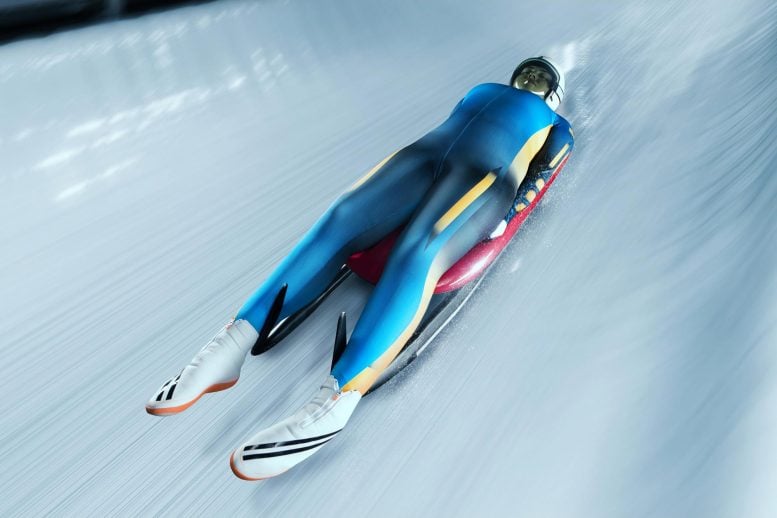
Bobsled, luge and skeleton athletes descend twisting, steep tracks at speeds upward of 80 mph (130 kmh).
Speed alone may be the factor that draws many sports fans to the bobsled, luge, and skeleton events at this year’s Beijing Winter Olympics. But beneath the thrilling descents of the winding, ice-covered track, a myriad of concepts from physics are at play. It is how the athletes react to the physics that ultimately determines the fastest runs from the rest of the pack.
I study the physics of sports. Much of the excitement of a luge run is easy to miss – the athletes’ movements are often too small to notice as they fly by looking like nothing more than a blur on your television. It would be easy to assume that the competitors are simply falling or sliding down a track at the whim of gravity. But that thought merely scratches the surface of all the subtle physics that go into a gold-medal-winning performance.
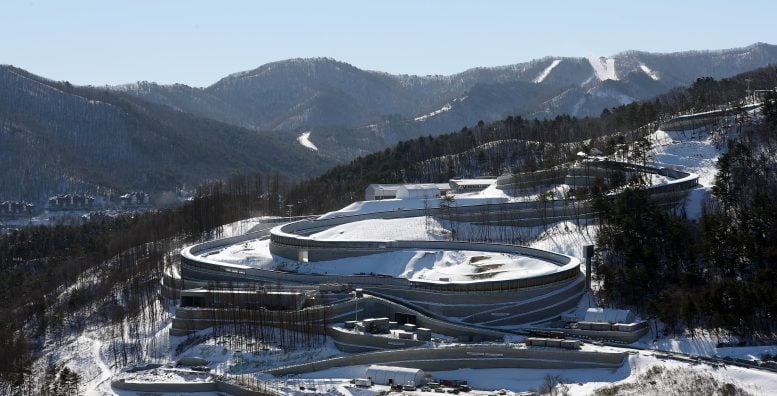
Tracks for sliding events – like the Olympic track from the 2018 Pyeongchang Winter Olympics – drop hundreds of feet and feature many tight turns. Credit: Korean Culture and Information Service
Gravity and energyGravity is what powers the sleds down the ice-covered tracks in bobsled, luge and skeleton events. The big-picture physics is simple – start at some height and then fall to a lower height, letting gravity accelerate athletes to speeds approaching 90 mph (145 kph).
This year’s races are taking place at the Yanqing National Sliding Center. The track is roughly a mile long (1.6 km), drops 397 feet of elevation (121 meters) – with the steepest section being an incredible 18% grade – and comprises 16 curves.
Riders in the sledding events reach their fast speeds because of the conversion of gravitational potential energy into kinetic energy. Gravitational potential energy represents stored energy and increases as an object is raised farther from Earth’s surface. The potential energy is converted to another form of energy once the object starts falling. Kinetic energy is the energy of motion. The reason a flying baseball will shatter the glass if it hits a window is that the ball transfers its kinetic energy to the glass. Both gravitational potential energy and kinetic energy increase as weight increases, meaning there is more energy in a four-person bobsled team than there is in a one-person luge or skeleton for a given speed.
Racers are dealing with a lot of kinetic energy and strong forces. When athletes enter a turn at 80 mph (129 kph) they experience accelerations that can reach five times that of normal gravitational acceleration. Though bobsled, luge and skeleton may look easy, in reality they are anything but.
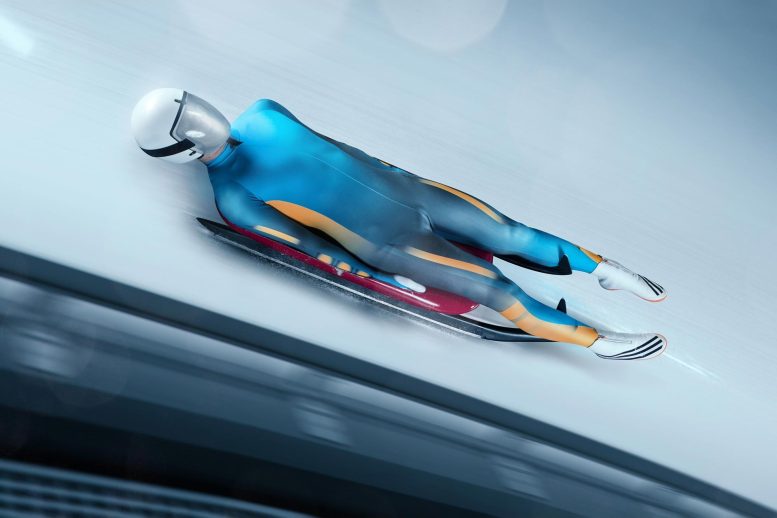
Racers need to be as aerodynamic as possible to minimize drag and go faster.
AerodynamicsMost tracks are around a mile long (1.6 km), and the athletes cover that distance in just under a minute. Final times are calculated by adding four runs together. The difference between the gold medal and silver medal in the men’s singles luge at the 2018 Winter Olympics was just 0.026 seconds. Even tiny mistakes made by the best athletes in the world can cost a medal.
All the athletes start at the same height and go down the same track. So the difference between gold and a disappointing result comes not from gravity and potential energy, but from a fast start, being as aerodynamic as possible and taking the shortest path down the track.
While gravity pulls the athletes and their sleds downhill, they are constantly colliding with air particles that create a force called air drag, which pushes back on the athletes and sleds in a direction opposite to their velocity. The more aerodynamic an athlete or team is, the greater the speed.
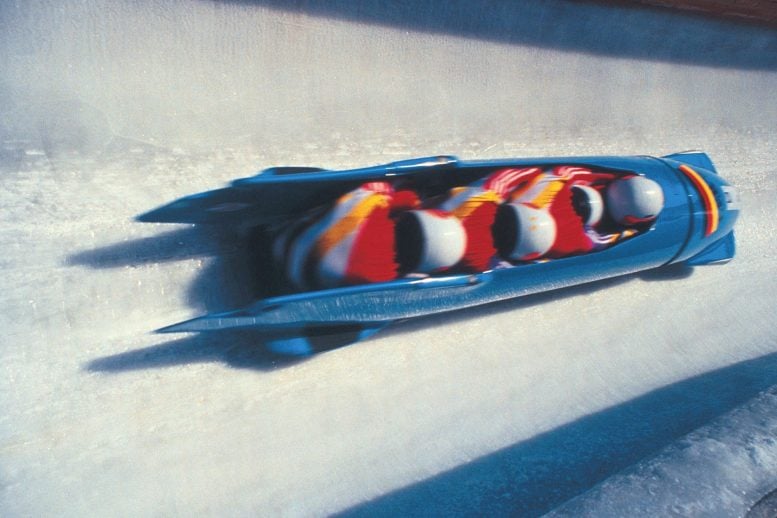
Bobsled teams must tuck themselves behind the leading edge of the sled to avoid the oncoming air.
To minimize drag from the air, luge riders – who are face up – lie as flat as possible. Downward-facing skeleton riders do the same. Whether in a team of two or four, bobsled riders stay tucked tightly inside the sled to reduce the area available for air to smash into. Any body positioning mistakes can make athletes less aerodynamic and lead to tiny increases in time that can cost them a medal. And these mistakes are tough to correct at the high accelerations and forces of a run.
The shortest way downBesides being as aerodynamic as possible, the other major difference between a fast and a slow run is the path riders take. If they minimize the total length taken by their sleds and avoid zigzagging across the track, riders will cover less distance. In addition to simply not having to go as far to cross the finish line, shortening the path means facing less drag from air and losing less speed from friction with the track.
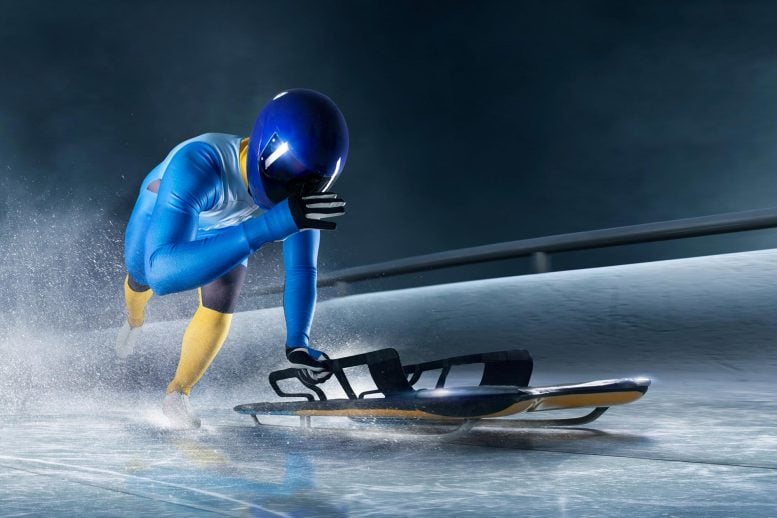
Skeleton racers don’t have a means of directly controlling the runners, so they must use subtle body movements to flex the sled and initiate turns.
Fans often miss the subtleties involved in turning and steering. The sleds for all the events sit on steel blades called runners. Bobsleds have two sets of runners that make contact with the ice. The front rider pulls on rings attached to pulleys that turn the front runners. Runners on luge sleds have curved bows at the front where riders place their calves. By moving their head and shoulders or flexing their calves, athletes can turn the luge. Skeleton riders lack these controls and must flex the sled itself using their shoulders and knee to initiate a turn. Even a tiny head movement can cause the skeleton to move off the optimal path.
All of these subtle movements are hard to see on television, but the consequences can be large – oversteering may lead to collisions with the track wall or even crashes. Improper steering may lead to bad turns that cost riders time.
Though it may appear that the riders simply slide down the icy track at great speeds after they get going, there is a lot more going on. Viewers will have to pay close attention to the athletes on those fast-moving sleds to detect the interesting facets of physics in action.
Written by John Eric Goff, Professor of Physics, University of Lynchburg.
This article was first published in The Conversation.![]()